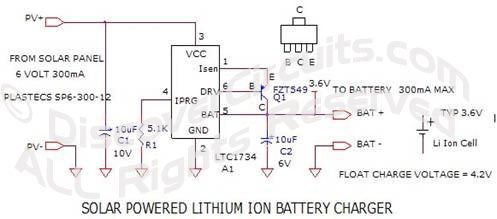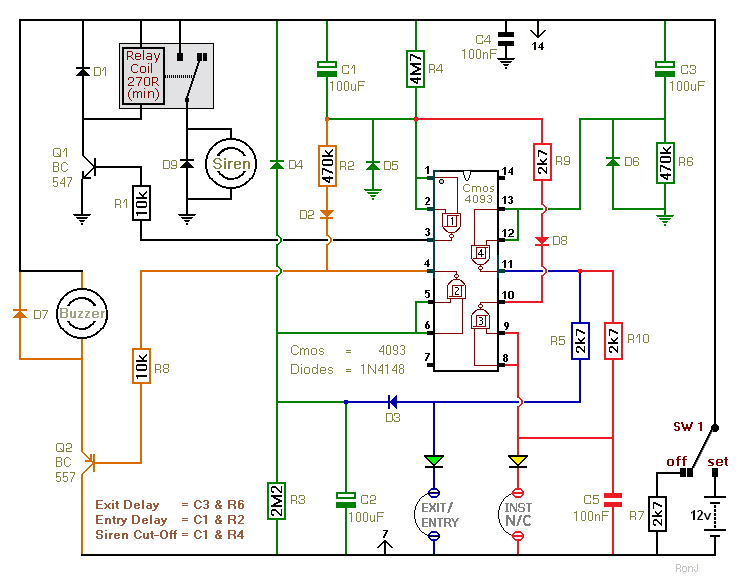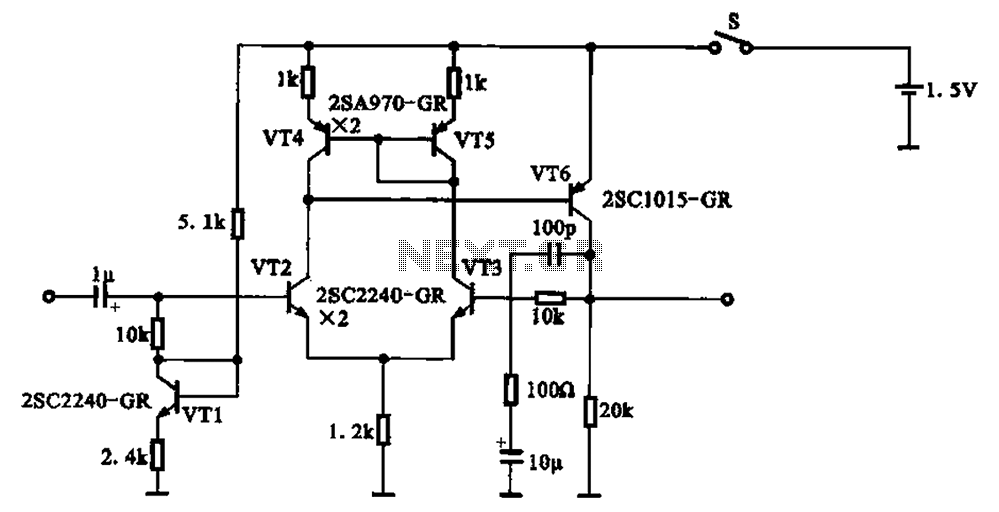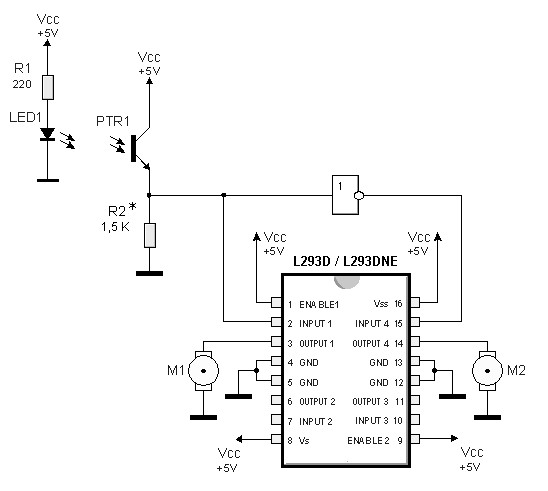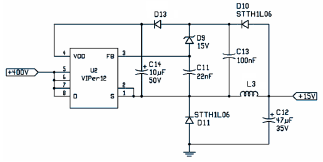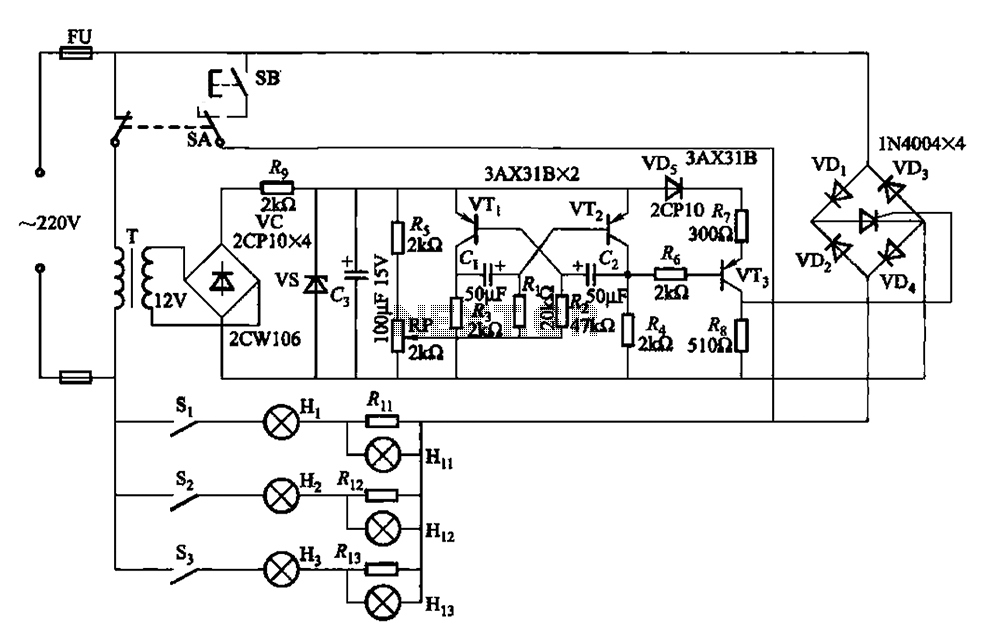
TA2022 and TAS5010 digital amplifier circuit diagram
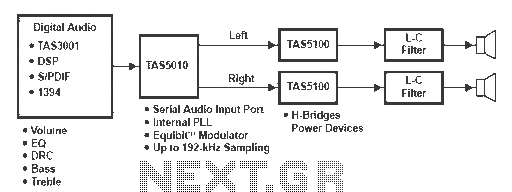
A digital amplifier is a new device that IC manufacturers are eager to capitalize on, leading to the launch of unique digital amplifier products. Below are brief descriptions of some representative devices. The TA2022, produced by Tripath, is an integrated stereo analog input modulator and output stage. It is notable for employing a spread spectrum modulation mode switch, rather than a fixed frequency, which is why it is referred to as a "T type" amplifier. The device operates at a supply voltage of 25V and can output 25W per channel on an 8-ohm load, with an idle power consumption of 3.4W. The TA2022 has a total harmonic distortion (THD) of 0.015% at 25W, rising to 0.1% at 60W. It is packaged in an SSIP-32 plastic package that requires an additional radiator. The Cirrus Logic CS4421 is a Class D controller that works with a pair of IR's IRCS8001 bridge drivers. The CS4421 can accommodate three serial digital audio inputs, featuring a built-in multi-way switch and the main interface, and is housed in a TSSOT-24 package. The IRCS8001 bridge driver, packaged in SOIC-16, drives four IRC8101 MOSFETs in a full-bridge, half-bridge, or two IRC8102 MOSFET structure, providing 50W power at an 8-ohm speaker. The amplifier exhibits a THD of 0.01% at 1W and 0.1% at full power, ensuring a good stereo effect. TI's true digital amplifier (TDAA) includes the TAS5010 PCM-PWM modulator and TAS5100 digital amplifier components. This system accepts a serial PCM digital audio stream and converts it into a 3.3V PWM audio stream, which is then amplified into a large signal PWM and demodulated to drive speakers. The TAS5010 is based on Equibit technological innovation, providing a high-performance, cost-effective 24-bit stereo PCM-PWM modulator. It supports various serial input formats, including left justified, right justified, IIS, or DSP data format, and is fully compatible with the AES standard sampling rate, providing de-emphasis. The device also features an internal digital interpolation filter that processes audio data at 2x, 4x, or 8x (depending on the sampling rate) or up to 384KHz sampling down to 352.8KHz, which is the TDAA's internal sampling rate. The Equibit modulator converts a sampled signal into a PWM signal using a patented correction algorithm to compensate for non-linearities, enhancing overall system performance. The TAS5100 is a single-channel PWM power audio device that includes an integrated gate drive, four matching and electrically isolated N-channel enhancement mode power DMOS transistors, and built-in protection and fault notification circuits. The dynamic range of the TDAA system exceeds 93dB, with a THD of less than 0.08% (1KHz, 6-ohm load, 1W to 30W RMS), and power efficiency greater than 90% at an 8-ohm load. Practical tips for using digital amplifiers highlight that while Class D amplifiers offer many advantages, they also present inherent challenges that must be addressed during actual use. It is crucial to recognize that Class D pulse amplifiers are sensitive to power quality. The power supply must provide fast-changing currents without producing ringing voltage waveforms or causing fluctuations. This necessitates the use of storage capacitors with very low effective series resistance (ESR). Any parasitic resistance or inductance can hinder the rapid transfer of stored charge, making it essential for all parallel capacitors to have low ESR. Utilizing a switching power supply is often the most effective solution, as these supplies operate at higher frequencies and can quickly respond to load changes without the need for additional voltage regulators. This not only reduces the size of storage capacitors but also enhances the overall efficiency of the power supply, thereby minimizing cooling requirements. Another common issue with Class D amplifiers is electromagnetic interference (EMI). The copper traces and cables connected to the output stage can act like antennas, carrying high-frequency signals. To mitigate EMI, it is advisable to keep these connections as short as possible, ideally placing the power supply and output stage on the same PCB. For built-in speaker systems, short speaker cables can effectively reduce EMI while also lowering costs. However, if external speakers are used, the length of the cables may exceed the designer's control, making a low-pass filter essential for the output stage. Such filters can inhibit low-frequency EMI but may also attenuate high-frequency audio components. High-order filters, while effective, can incur high costs, particularly concerning inductors that must avoid electromagnetic core saturation. A digital speaker equalizer can provide a viable solution by allowing for programmable adjustments to enhance the sound quality, using low-cut frequency filters in the audio range while maintaining a flat frequency response. For a 384KHz PWM signal, to prevent attenuation of mid-range frequencies, the filter cutoff frequency should be around 45KHz, while the equalizer can enhance the treble cutoff frequency as low as 30KHz, effectively reducing EMI by approximately 7dB.Digital Amplifier is a new device, IC manufacturers will not miss this opportunity, have launched a unique digital amplifier products. Briefly describes some representative devices below. TA2022 is Tripath production integrated stereo analog input modulator and output stage. It's unusual in that it uses spread spectrum modulation mode switch, rather than a fixed frequency, so the company called "T type" amplifier. The device supply voltage at 25, each channel can output 25W on 8 load power, idle power consumption was measured to 3.4W.
TA2022 has a 0.015% THD at 25W; 60W when the rise was 0.1%. It is packaged in SSIP-32 plastic package required plus radiator. Cirrus Logic CS4421) is a class D controller that with a pair of IR's IRCS8001 bridge driver with use. 4421O can have a 3-way serial digital audio inputs, built-in multi-way switch and the main interface, using TSSOT-24 package.
IRCS8001 bridge driver uses SOIC-16 package, each drive 4 IRC8101 MOSFET full-bridge, half-bridge or two IRC8102 MOSFET structure, access to 50W power at 8 speaker. Amplifier THD in 1KH z, 1W at 0.01%; 0.1% of this amplifier combination can get a good stereo effect at full power.
alt=""> TI's true digital amplifier (TDAA) by the TAS5010 PCM-PWM modulator and TAS5100 digital amplifier components. The system accepts serial PCM digital audio stream and converted to 3.3V PWM audio stream, then amplified into large signal PWM, and then after demodulation drive speakers.
TAS5010 is based Equibit technological innovation, high-performance, cost-effective 24-bit stereo PCM-PWM modulator. The device has a variety of serial input format options: including left justified, right justified, IIS or DSP data format and is fully compatible with the AES standard sampling rate, also provides de-emphasis.
There is also a 5010 internal digital interpolation filter, the audio data at 2x, 4x, or 8x (depending on the sampling rate) or 384KHz sampling to 352.8KHz on, this rate is TDAA internal sampling rate. Equibit modulator will be converted into a sampled signal on the same frequency PWM signal modulator using a sound patent correction algorithm to compensate for non-linear, improve overall system performance.
TAS5100 is a single-channel PWM power audio device, which consists of an integrated gate drive, four matching and electrically isolated N-channel enhancement mode power DMOS transistors, built-in protection circuit and fault inform circuit. Dynamic range by the two devices composed of TDAA system is greater than 93dB; TDH less than 0.08% (1KHz, 6 load, 1W ~ 30W RMS); on 8 load power efficiency greater than 90%.
Digital amplifier practical tips Although Class D amplifiers have many advantages, but it also has its own inherent problems in actual use to deal with properly. Please do not forget this basic fact that D0 pulse amplifier is working, more sensitive to power quality.
Power in the provision of fast-changing currents should not produce ringing voltage waveform or make changes. This requires the storage capacitor having a very low effective series resistance (esr), any parasitic resistance or inductance as would prevent fast stored charge transfer.
An electrolytic capacitor in parallel with a small low-esr capacitor is useless, because the output power is the sudden shift in a short time, all of the parallel capacitors are required to have low esr. Using switching power supply may be the most effective way to solve the problem. Such power supply typically operates at a higher frequency and with a built-in load fast, without after wiring of voltage regulators, high frequency helps reduce storage capacitor, not only that, the efficiency of the switching power supply is higher than linear power supply, energy reduce the cooling requirement.
Class D amplifier Another common problem is electromagnetic interference (EMI). All connected to the output stage of PCD copper traces and cables carrying high-frequency, its role is like a antenna. The easiest way to reduce EMI is to make these connections as short as possible, able to do so, the power supply and output stage should be placed on the same PCB.
Speaker microphone are more hard to deal with. If the built-in speaker system is set up, the short speaker cable is an effective means to overcome EMI, but also reduce costs. If the speakers are external, the cable length is beyond the scope of the designer can control the output stage low-pass filter is essential.
Low-pass filter will bring yet another trade-offs, not only inhibits the low cut-off frequency EMI, will attenuate the high-end audio component with a high-order filter to meet the above requirements, but the cost is too high and people can not accept, especially filter inductance, which have high quality and avoid electromagnetic core saturation. Digital speaker equalizer provides a solution. When it is programmed to triple tone improved, it is possible to use a low cut-off frequency of the low-level reconfigurable filters in the audio range and still maintain a flat frequency response.
Rate of 384KHz PWM signal, in order to prevent the triple sound attenuation, filter cutoff frequency is about 45KHz. EQ to enhance the sound of the triple cutoff frequency as low as 30KHz. EMI can be reduced 7dB.
TA2022 has a 0.015% THD at 25W; 60W when the rise was 0.1%. It is packaged in SSIP-32 plastic package required plus radiator. Cirrus Logic CS4421) is a class D controller that with a pair of IR's IRCS8001 bridge driver with use. 4421O can have a 3-way serial digital audio inputs, built-in multi-way switch and the main interface, using TSSOT-24 package.
IRCS8001 bridge driver uses SOIC-16 package, each drive 4 IRC8101 MOSFET full-bridge, half-bridge or two IRC8102 MOSFET structure, access to 50W power at 8 speaker. Amplifier THD in 1KH z, 1W at 0.01%; 0.1% of this amplifier combination can get a good stereo effect at full power.
alt=""> TI's true digital amplifier (TDAA) by the TAS5010 PCM-PWM modulator and TAS5100 digital amplifier components. The system accepts serial PCM digital audio stream and converted to 3.3V PWM audio stream, then amplified into large signal PWM, and then after demodulation drive speakers.
TAS5010 is based Equibit technological innovation, high-performance, cost-effective 24-bit stereo PCM-PWM modulator. The device has a variety of serial input format options: including left justified, right justified, IIS or DSP data format and is fully compatible with the AES standard sampling rate, also provides de-emphasis.
There is also a 5010 internal digital interpolation filter, the audio data at 2x, 4x, or 8x (depending on the sampling rate) or 384KHz sampling to 352.8KHz on, this rate is TDAA internal sampling rate. Equibit modulator will be converted into a sampled signal on the same frequency PWM signal modulator using a sound patent correction algorithm to compensate for non-linear, improve overall system performance.
TAS5100 is a single-channel PWM power audio device, which consists of an integrated gate drive, four matching and electrically isolated N-channel enhancement mode power DMOS transistors, built-in protection circuit and fault inform circuit. Dynamic range by the two devices composed of TDAA system is greater than 93dB; TDH less than 0.08% (1KHz, 6 load, 1W ~ 30W RMS); on 8 load power efficiency greater than 90%.
Digital amplifier practical tips Although Class D amplifiers have many advantages, but it also has its own inherent problems in actual use to deal with properly. Please do not forget this basic fact that D0 pulse amplifier is working, more sensitive to power quality.
Power in the provision of fast-changing currents should not produce ringing voltage waveform or make changes. This requires the storage capacitor having a very low effective series resistance (esr), any parasitic resistance or inductance as would prevent fast stored charge transfer.
An electrolytic capacitor in parallel with a small low-esr capacitor is useless, because the output power is the sudden shift in a short time, all of the parallel capacitors are required to have low esr. Using switching power supply may be the most effective way to solve the problem. Such power supply typically operates at a higher frequency and with a built-in load fast, without after wiring of voltage regulators, high frequency helps reduce storage capacitor, not only that, the efficiency of the switching power supply is higher than linear power supply, energy reduce the cooling requirement.
Class D amplifier Another common problem is electromagnetic interference (EMI). All connected to the output stage of PCD copper traces and cables carrying high-frequency, its role is like a antenna. The easiest way to reduce EMI is to make these connections as short as possible, able to do so, the power supply and output stage should be placed on the same PCB.
Speaker microphone are more hard to deal with. If the built-in speaker system is set up, the short speaker cable is an effective means to overcome EMI, but also reduce costs. If the speakers are external, the cable length is beyond the scope of the designer can control the output stage low-pass filter is essential.
Low-pass filter will bring yet another trade-offs, not only inhibits the low cut-off frequency EMI, will attenuate the high-end audio component with a high-order filter to meet the above requirements, but the cost is too high and people can not accept, especially filter inductance, which have high quality and avoid electromagnetic core saturation. Digital speaker equalizer provides a solution. When it is programmed to triple tone improved, it is possible to use a low cut-off frequency of the low-level reconfigurable filters in the audio range and still maintain a flat frequency response.
Rate of 384KHz PWM signal, in order to prevent the triple sound attenuation, filter cutoff frequency is about 45KHz. EQ to enhance the sound of the triple cutoff frequency as low as 30KHz. EMI can be reduced 7dB.
